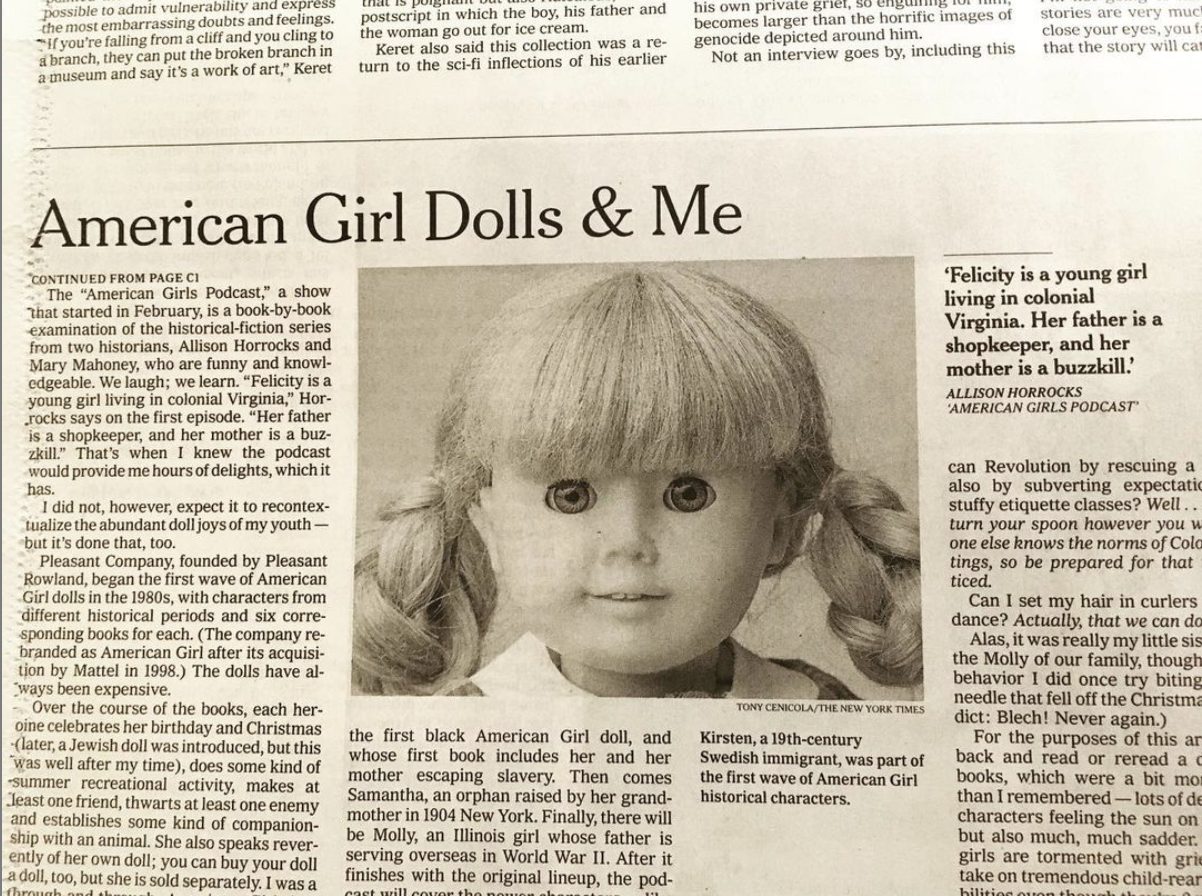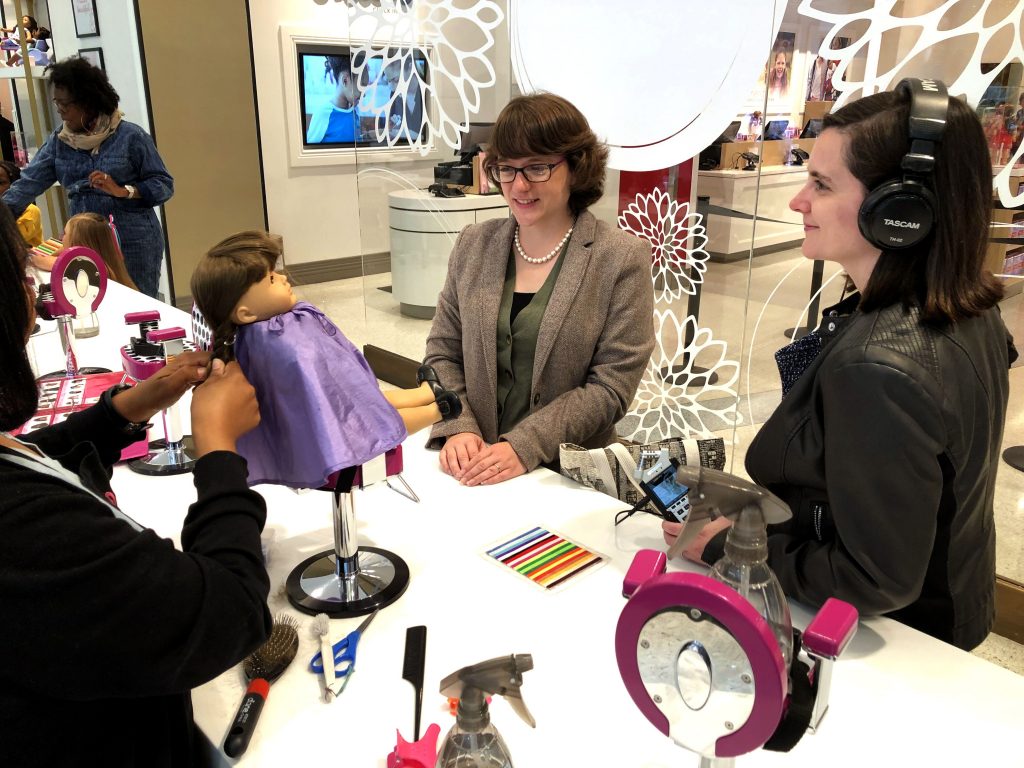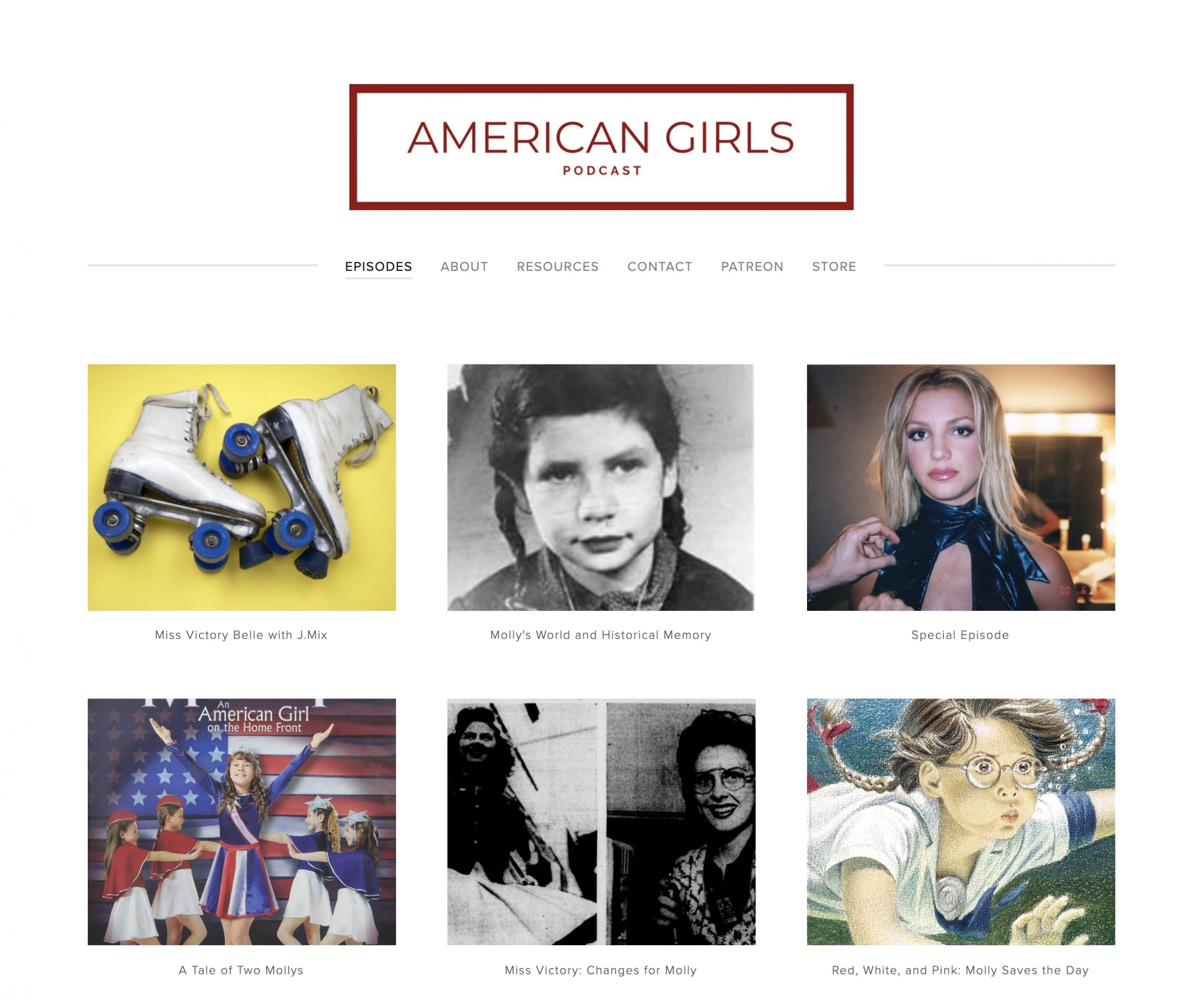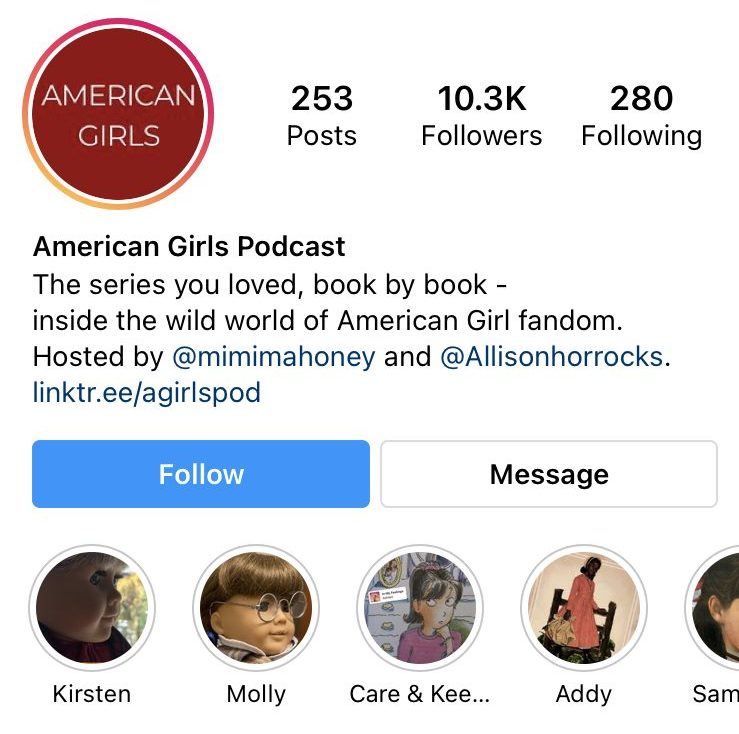Our American Girls
What do you do with a history doctorate and a pop culture obsession? If you’re these two alums, you create a hit podcast centering on ’90s nostalgia.
ByJulie (Stagis) Bartucca ’10 (BUS, CLAS), ’19 MBA
Illustrations by Brian Lutz and Christa Yung
I
f you’re surprised to learn that a podcast about the American Girl children’s series of historical fiction books, best known for its accompanying dolls, has amassed 30,000 downloads a month from listeners all over the world and spawned a book deal, you’re not alone.
“I thought the group of friends I watch ‘The Bachelor’ with would listen to this show, and my wife, and that would be it,” says Mary Mahoney ’18 Ph.D., a historian who created and hosts the “American Girls” podcast with her friend and fellow UConn history grad Allison Horrocks ’16 Ph.D. “I wanted a reason to hang out with my friend every other week. I had absolutely no idea we would have the kind of listenership we have.”
If you’re surprised to learn that a podcast about the American Girl children’s series of historical fiction books, best known for its accompanying dolls, has amassed 30,000 downloads a month from listeners all over the world and spawned a book deal, you’re not alone.
“I thought the group of friends I watch ‘The Bachelor’ with would listen to this show, and my wife, and that would be it,” says Mary Mahoney ’18 Ph.D., a historian who created and hosts the “American Girls” podcast with her friend and fellow UConn history grad Allison Horrocks ’16 Ph.D. “I wanted a reason to hang out with my friend every other week. I had absolutely no idea we would have the kind of listenership we have.”
The show’s blend of astute historical analysis, warm banter between close friends, and copious pop culture references has earned it a global community of fans. In one 71-minute episode, the hosts discuss the American Girl book “Meet Samantha,” about an orphan living with her wealthy grandmother in 1904 New York. During that episode, the following such pop culture artifacts, along with a few straight up literary and historical references, are mined at various depths:
- American figure skater Nancy Kerrigan
- the 2000 book “Bowling Alone: The Collapse and Revival of American Community”
- Garth Brooks: “The Road I’m On” documentary series
- American figure skater Kristi Yamaguchi
- Dante
- Freddie Mercury
- The Beatles
- Gwyneth Paltrow, Goop, and Blythe Danner
- Depression-era photojournalist Dorothea Lange
- the “Eloise” books
- Pride Month
- “The Help,” and its problematic Netflix popularity during last summer’s racial justice protests
- George Edwin Taylor — the first Black man to run for president, the NAACP, and Ida B. Wells
- novelist V.C. Andrews
- “Bohemian Rhapsody” (the movie)
- Alice James (Henry’s sister)
- “The Barefoot Contessa” Ina Garten and her husband, Jeffrey
- Prince Edward
- Kelly Clarkson and her divorce
Seriously Silly
As doctoral students in Storrs, Horrocks and Mahoney bonded over the way they both identified strongly with Molly McIntire, one of three original American Girl characters, a spunky, bespectacled World War II–era girl sporting brown braids.
Early in their friendship, they discovered they also shared a passion for taking pop culture more seriously than most, perhaps best evidenced by an argument over who was at fault in actress Reese Witherspoon’s divorce, which spurred Mahoney to create a Google doc for the women to lay out their cases titled “The People vs. Ryan Phillippe.”
Mahoney trained as a DJ at the UConn radio station WHUS. Creating a podcast in which the two friends revisited the books of their youth as learned historians became a shared goal, a reward for completing their doctorates.
“We had a friend who told us, ‘I would pay to hear you two go through an US Weekly,’” says Mahoney, who is by day the digital scholarship coordinator at Trinity College in Hartford. “What you hear on the show, that’s how we talk to each other. We take things seriously that are not, but we also take history seriously. We just wanted to do something that was meaningful to us without apology.”
So while they bring decades of schooling to their reflections on the books’ historical contexts and the way they are portrayed, they are just as comfortable going deep on the perfection of “Grease 2.” Or dissolving into fits of laughter after Mahoney responds to a plot development in one Molly book with a quote attributed to Wynonna Judd that she saw on a Starbucks cup: “You can either be right or be loved.”
“Stop! No!” Horrocks protests. “That’s, like, neoliberal nonsense. No!”
It may not be for everyone — among hundreds of glowing five-star reviews on Apple Podcasts are a handful that complain about the non–American Girl aspects of the show and even the critical eye the hosts take toward the books’ characters — but for Horrocks and Mahoney, the “secret sauce” lies in their authenticity.
“I think part of what pulls people in is we’re not fake. There’s a sincerity we bring to it,” says Horrocks. “We record, conservatively, four hours of tape together a month. You can’t fake that.”
When people in podcasting talk about what works, “a lot of it is that you have a chemistry that people want to listen to — or you don’t,” she says. And to be sure, trying to be anything but themselves would not fit Horrocks’ or Mahoney’s style.

A fan crafted Mary and Allison as American Girl dolls

“I knew the podcast would provide me hours of delights ... I did not, however, expect it to recontextualize the abundant doll joys of my youth — but it’s done that too,” wrote Margaret Lyons in this New York Times article

BFFs — Horrocks (left) was the one friend Mahoney invited to her pandemic wedding
“What you hear on the show, that's how we talk to each other. We take things seriously that are not, but we also take history seriously.”
Coming of Age
In elementary school, Mary Mahoney transferred from public school to Catholic school. One of her first assignments was to write a letter to Santa.
“I wrote mine to Mrs. Claus because I thought it was unfair that nobody ever wrote to her, and she probably did a lot of work,” Mahoney says. “At the bottom, I wrote ‘P.O.W.: Power of Women.’ My teacher sent the letter home and I thought I was in trouble, but I think she was trying to say, ‘We’ve got a live one here.’
“That’s what I was like at 9. I haven’t gotten much taller, and my viewpoints haven’t changed much.”
Growing up in Wethersfield, one of the oldest towns in Connecticut, with a librarian mom and a history-buff dad, Mahoney explored history and feminism largely through the writings of other girls, and was drawn to American Girl books “because they centered the stories of young girls like me.”
Eighty miles east, Horrocks was coming of age in Rhode Island, an avid reader who also loved the American Girl books. She was into science, competing in school science fairs and initially pursuing a pre-med path before realizing she was simply too squeamish and didn’t find the coursework interesting.
Though both graduated from Trinity College in 2009 with degrees in history and American studies (Horrocks) and history and English (Mahoney), the two barely crossed paths before coming to UConn.
The two women, both public historians passionate about making history accessible to the masses, pull podcast inspiration and knowledge from their experiences teaching as graduate assistants and creating an exhibit for the Dodd Center while they were at UConn.
Mahoney recalls using current topics to pull uninterested students into important subjects, for example, and Horrocks says learning to explain their WWI exhibit to “a group of women in a rec center who just had dinner and a two hour meeting” gave her the tools to break history down in a way that appeals to everyone.
“We want someone who could be curious about history, but feels like, ‘I didn’t go to college for that. It might not be for me,’ to get over that imposter syndrome. We’re talking to you and we want you to talk back to us and be part of the conversation,” says Mahoney.
One of Horrocks’ favorite parts of her day job — as a park ranger at Lowell National Historical Park in Lowell, Massachusetts — is “making history real for people.” She brings that same energy to the show.
“We definitely see what we’re doing as being historians and being academic. But to us, it’s having a wider view of who that’s for,” Mahoney says. “It should not be something that’s just for a handful of people who have the same credentials that you do. It should be welcoming and inclusive and representative of how you imagine the public to be.”

Recording live at the American Girl store in New York City

Addy and her mother are based on real self-freed enslaved people

Horrocks and Mahoney question the blind patriotism portrayed in Molly’s World War II stories

Horrocks and Mahoney keep boxes of fan art, like this embroidery
Wrestling with Privilege
Centering a show around a brand like American Girl means the hosts have to work to dissect representation and inclusion. The nature of American Girl inherently means that the audience will be overwhelmingly female, overwhelmingly middle class, and overwhelmingly white.
American Girl began in 1986 as a catalog-only operation selling a number of dolls that represented fictional characters, each from a specific historical period and background, along with accessories and a series of books about each character.
Purchased by Mattel in 1998, American Girl has since grown to include different lines such as “Girl of the Year” dolls, hawked not only online and in catalogs but at giant retail stores in more than a dozen North American cities that also feature doll hair salons and restaurants for doll-and-girl tea parties.
That the whole thing reeks of privilege — the items have always been pricey; today, a “Historical Character” doll and book set will set you back $110 — is not lost on Horrocks and Mahoney. Though the focus of their historical interrogation is on the stories, “we talk a lot about the super middle class marker of privilege it is to have any of this stuff,” Mahoney says.
“We have listeners who couldn’t have an American Girl doll as children and bought it as adults, people who would salivate over the catalogs or who would buy the dolls secondhand and make clothes. It’s important to us to make explicit the class issues inherent in this brand,” she says. “The privilege of their life allows them to be blind to it if they want to be. A lot of our listeners, to their credit, don’t want to be like that.”
So in diving into the stories they loved as children, the hosts bring a new lens that allows them to challenge the beloved stories and their shortcomings, to examine how they might have been a product of the times during which they were written, and to reflect on how the same issues persist today.
“They're expert historians, they're best friends, and they also have something important to say about Justin Timberlake.”
Keeping it Real
Before giving too much credit to the company for introducing Addy, the first Black American Girl, in 1993, the hosts point out the complexities of Black girls being happy to have a doll that looks like them, but conflicted about the character being born into slavery and then self-liberated with her mother. Despite their decades-long love for Molly, the hosts weren’t shy about questioning the practical absence of the Holocaust from her stories, which take place during World War II.
“The stakes have always been somewhat high when you’re writing a book about what it means to be a person of a country or what it means to be an American girl. But I think it’s so hard to read Molly with any kind of neutrality when we have QAnon and we have fascism on the rise and we have people with Nazi memorabilia and with Auschwitz sweatshirts storming the Capitol,” Horrocks says during one of the Molly episodes.
“It is very difficult to see this sort of uncomplicated embrace of patriotism that’s now being taught to these 9-year-olds [reading the Molly books] that does not speak at all about the true origins or driving factors of this war,” she says.
“We can’t help but note that we are in book five, and there’s still no mention of the Holocaust. It’s so irresponsible to me that it’s not in these books, and it’s harder and harder to ignore.”
“Some listeners didn’t love hearing that their favorite book has done something wrong,” Mahoney says.
“We’re saying why is this, what are these books inviting us to think about the 1990s, 1980s, and today? This erasure matters, and noting it matters because it’s still happening now. You can bring that self-awareness to your life.”
The pandemic and racial unrest that heightened over the past year added further dimension to the show. While wrapping up production on a long-planned episode dissecting old American Girl catalogs last summer, Black Lives Matter protests hit a boiling point.
“Our timing could not have been worse. We had an episode we were proud of, but we didn’t speak to what was going on,” Horrocks says.
“We’re historians — we understand when it’s time to take up space and when it’s not. While you’re living through a civil rights movement, it’s not that what we were doing was silly or unimportant, but there were other things to talk about.”
While they are aware that listeners look to the show for a light escape from reality, they were intentional in shifting the balance as 2020 unfolded.
“It is a time capsule. We don’t want people to look back and say, ‘Were they really talking about $30 accessories the weekend people were being beaten while marching for their lives?’” says Horrocks. “If you’re creating something and putting it out in the world and you didn’t think about it differently between last February and this February, you’re probably not saying anything.”
But like the girls in the American Girl stories, these two women are complex. They’re expert historians, they’re best friends, and they also have important things to say about Justin Timberlake.
And that’s what makes “American Girls” the podcast work.
“We had people tweet at us in the beginning saying, ‘I was going to do a podcast about American Girl,’” Horrocks says. “And I’m like, ‘But you didn’t. We did.’”

The podcast has more than 30,000 downloads per episode . . .

. . . and over 10,000 followers on Instagram

Mahoney with the first book covered on the podcast

FYI…another UConn graduate, Jacqueline Dembar Greene (https://www.jdgbooks.com/) is the author of the “Rebecca” series of American Girls books.